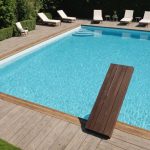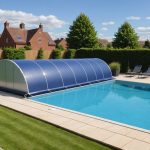Creating a coastal green living fence enhances your home's privacy while providing essential wind resistance, especially in the UK’s exposed areas. This sustainable gardening solution not only beautifies your property but also offers environmental benefits. With a simple step-by-step guide, you’ll learn how to select the right plants and design a fence that thrives in coastal conditions. Transform your outdoor space into a serene and resilient retreat, while protecting it from the elements. Discover how easy it is to embrace nature while achieving practical enhancements for your home.
Overview of Coastal Green Living Fences
Coastal green living fences are an innovative solution for creating privacy and enhancing wind resistance in coastal areas. These fences are essentially dense hedgerows or plant barriers that serve multiple purposes, primarily offering a natural screen from prying eyes and acting as an effective windbreak. This dual functionality is particularly beneficial in coastal regions where privacy can be scarce and harsh winds are common.
Dans le meme genre : Enhancing Indoor Air Quality in UK New-Builds: A Guide to Optimizing Mechanical Ventilation Systems
The coastal environment in the UK presents unique challenges due to its exposure to strong winds and salt-laden air. These conditions can be detrimental to traditional fencing materials, making green living fences a more sustainable option. The plants used in these fences are typically chosen for their resilience to such conditions, ensuring they thrive where other options might fail.
In addition to their practical benefits, these fences contribute to the local ecosystem by providing habitats for wildlife and improving air quality. They also add aesthetic value to properties, blending seamlessly with the natural landscape. As a result, coastal green living fences are not just a practical choice but also a sustainable and visually appealing one for those living in coastal environments.
A lire en complément : Expert Tips for Preserving Original Woodwork in Your UK Heritage Home
Suitable Plant Selection for Coastal Conditions
When selecting coastal plants for green living fences, it's crucial to consider their ability to withstand harsh environmental conditions. Plants that thrive in coastal areas often have unique characteristics, such as salt tolerance and robust root systems, which help them endure strong winds and saline air. These features are essential for maintaining a healthy and resilient living fence.
Native species are often the best choice for coastal environments, as they are naturally adapted to local conditions. For privacy and wind resistance, consider using plants like Sea Buckthorn, which is known for its dense foliage and durability. Another excellent option is the Common Privet, which provides excellent coverage and can withstand salt spray.
Soil type is another critical factor in plant selection. Coastal soils can vary from sandy to loamy, and it's important to choose plants that can thrive in the available soil type. Additionally, selecting species with high salt tolerance ensures that the plants remain healthy despite the challenging conditions. By carefully choosing the right plants, you can create a sustainable and effective coastal green living fence that enhances both privacy and wind resistance.
Step-by-Step Installation Guide
Creating a coastal green living fence requires careful planning and execution. This guide provides a comprehensive overview of each step involved, ensuring a successful installation.
Preparing the Site
Begin by selecting an appropriate location for your fencing. Clear the area of debris, rocks, and existing vegetation. It's important to assess the soil quality and make necessary amendments. Coastal soils often benefit from added organic matter to improve fertility and drainage.
Planting Techniques
Once the site is prepared, focus on effective planting techniques. Dig holes twice the width of the plant's root ball to encourage root expansion. Position each plant at the same depth it was growing in its nursery pot. Firmly pack soil around the roots to eliminate air pockets, ensuring stability. Water thoroughly after planting to settle the soil.
Spacing Recommendations
Proper spacing is essential for optimal growth and privacy. Space plants according to their mature width to allow for natural expansion. For dense coverage, consider staggered rows. This ensures plants have sufficient room while maintaining an effective barrier. Regularly monitor plant health and adjust spacing if necessary to accommodate growth.
Maintenance and Care for Green Living Fences
Proper maintenance is essential to ensure the longevity and effectiveness of green living fences. This involves regular attention to watering, pruning, and fertilisation.
Watering, Pruning, and Fertilisation Guidelines
Watering is crucial, especially during dry spells. Ensure the soil remains moist but not waterlogged. Pruning helps maintain the desired shape and encourages healthy growth. Trim back any dead or diseased branches promptly. Fertilisation provides necessary nutrients. Use a balanced fertiliser in early spring to support growth.
Seasonal Care Tips for Coastal Plants
Coastal plants require specific seasonal care. In spring, focus on fertilisation and pruning. Summer demands vigilant watering due to increased evaporation. Autumn is the time to prepare plants for winter by reducing watering and applying mulch to retain soil moisture. Winter care involves protecting plants from harsh winds with windbreaks or temporary coverings.
Pest and Disease Management
Managing pests and diseases is vital. Coastal environments can foster unique challenges. Regularly inspect plants for signs of pests such as aphids or diseases like powdery mildew. Use environmentally friendly pest control methods, such as neem oil or insecticidal soap, to protect your living fence without harming the environment.
Legal and Environmental Considerations
Understanding the zoning regulations is crucial when planning a coastal green living fence in the UK. These regulations dictate where and how such fences can be installed, ensuring they align with local planning laws. Typically, zoning laws address the height and placement of fences to maintain neighbourhood aesthetics and safety. It's essential to consult with local authorities to ensure compliance before installation.
The environmental impact of green living fences is significant. They offer numerous benefits, such as improving air quality and providing habitats for local wildlife. These fences also contribute to the reduction of noise pollution and act as carbon sinks, absorbing CO2 from the atmosphere. By integrating natural elements, they enhance biodiversity and promote ecological balance.
For those seeking guidance, resources are available to navigate local guidelines. Community councils often provide detailed information on permissible fence types and installation procedures. Additionally, environmental organisations can offer insights into the ecological benefits and best practices for sustainable fence construction. Engaging with these resources ensures that your green living fence is both legally compliant and environmentally beneficial.
















